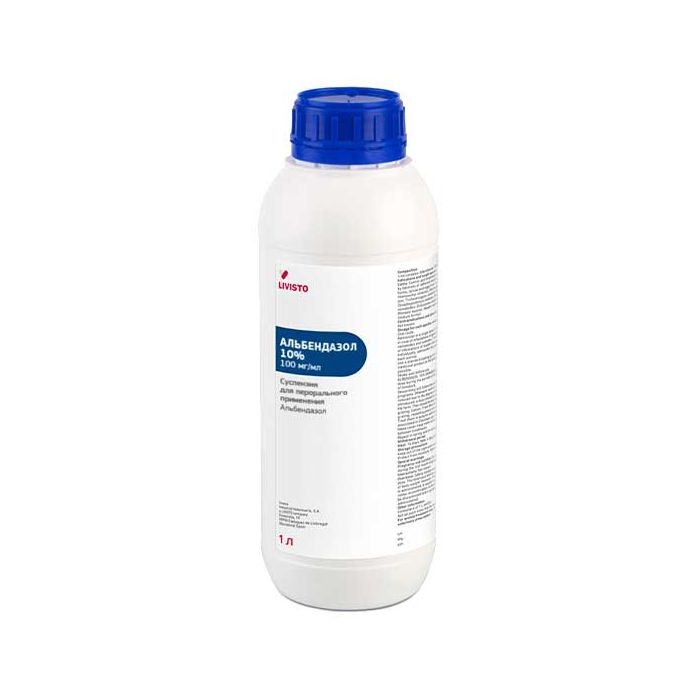Albendazole 10% 1L
DESCRIPTION
Albendazole suspension (Albendasolum suspension) - suspension for oral administration for deworming animals. In appearance, the drug is a homogeneous suspension of white or light gray color. During storage, delamination is allowed, which disappears after shaking.
COMPOSITION
In 100 g as an active ingredient, albendazole is 2.5 g or 10 g, respectively, as well as auxiliary substances: ethyl alcohol - 0.875 g and 3.5 g, respectively, water-soluble methylcellulose -1.75 g, citric acid - to pH 4- 5, distilled water - up to 100 g.
PHARMACOLOGICAL PROPERTIES
Albendazole suspension refers to broad-spectrum anthelmintic drugs.
Albendazole - methyl {5- (propylthio) -1-H-benziamidazol-2-yl} carbamate, which is part of the drug, has a wide spectrum of anthelmintic action, is effective in mono- and polyinvasions, is active against imago and larvae of nematodes, trematodes, as well as the imago of cestodes; having an ovocidal effect, it reduces the infection of pastures with helminth eggs.
Albendazole selectively inhibits the polymerization of beta-tubulin, disrupts the activity of the microtubular system of cells of the intestinal canal of helminths; suppresses the utilization of glucose, blocks the movement of secretory granules and other organelles in the muscle cells of roundworms, causing their death.
When administered orally, albendazole is absorbed in the gastrointestinal tract and penetrates into organs and tissues; excreted from the body mainly in the form of metabolites in the urine and in small quantities in feces.
Albendazole suspension according to the degree of impact on the body according to GOST 12.1.007 refers to low-hazard substances (hazard class 4). In recommended doses, the drug is well tolerated by animals, does not have hepatotoxic and sensitizing effects.
INDICATIONS
Albendazole suspension 10% - only for cattle with a therapeutic and prophylactic purpose for nematodes, trematodes and cestodoses, incl. bunostomiasis, cooperiosis, hemonchosis, nematodyrosis, esophagosgomosis, ostertagiasis, strongyloidiasis, trichostrongylosis, habertiosis, dictyocaulosis, protostrongylosis, mulleriosis, moniesiasis and fascioliasis.
DOSES AND METHOD OF APPLICATION
Deworming of animals for therapeutic purposes is carried out according to indications, with prophylactic - in the spring before pasture and in the fall before stalling.
Before mass treatments, each series of Albendazole suspensions is pre-tested on a small group of animals (10-15 animals), which are monitored for 3 days. In the absence of complications, the drug is used for the entire livestock.
The drug is administered once orally using a syringe-dispenser, inserting the tip of the cannula into the corner of the lip and injecting the drug as deeply as possible. Shake the suspension bottle before use. In cattle with nematodes and cestodes, the drug is administered at the rate of 0.75 ml for every 10 kg of the animal's weight, for fascioliasis - 1 ml for every 10 kg of the animal's weight.
SIDE EFFECTS
With proper use and dosage, side effects are usually not observed. Intoxication due to overdose is practically impossible, since the safety limit exceeds 5 times the therapeutic dose. The maximum tolerated dose for oral administration is 7.5 ml for every 10 kg of animal weight. If a higher dose is mistakenly administered, the animal may experience anorexia, sleeping sickness, weight loss, lethargy, and impaired gastrointestinal motility. In this case, you should stop the drug administration and apply symptomatic treatment.
CONTRAINDICATIONS
A contraindication to the use of the drug is the increased individual sensitivity of the animal to albendazole.
It is forbidden to use Albendazole for acute fascioliasis, during the breeding period, pregnant cows in the first third, and pregnant sheep and goats in the first half of pregnancy, as well as malnourished and sick animals with infectious diseases.
SPECIAL INSTRUCTIONS
Slaughter of animals for meat is allowed no earlier than 14 days after the use of the drug. The meat of animals that were forcedly killed before the expiration of the specified period can be used for feeding fur animals or for the production of meat and bone meal. Milk obtained from animals treated with the drug must not be used for food purposes within 4 days after the use of albendazole. Such milk can be used to feed animals.
SHELF LIFE AND STORAGE CONDITIONS
Store the medicinal product in the manufacturer's closed packaging in a dry, dark place, separate from food and feed, at a temperature of 2 В° C to 15 В° C.
The shelf life of the medicinal product, subject to storage conditions, is 2 years from the date of production.
PACKAGING
Albendazole suspension is released packaged in 1000 ml bottles in polymer bottles closed with screw-on plastic caps with first opening control.
Specifications
KolVUP
ten
Manufacturer
Livisto
Temperature regime
from +5 to +25
Teaser
deworming of cattle in case of dictyocaulosis, hemonchosis, ostertagiasis, trichostrongylosis, nematodyrosis, cooperiosis, esophagostomosis, moniesiasis and fascioliasis

